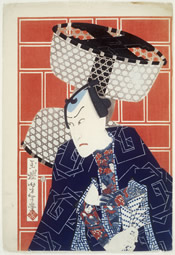
Colour print from woodblocks, with textile printing (nunomezuri), and gloss black (tsuyazumi), and with blackened lead white. Ôban format.
Block-cutter: Matsushima Hori Masa. Publisher: Daikin. 08/1865
Keyes 145
From the series A Celebration of Gallantry (Isami no kotobuki), each showing a leading actor as a tattooed fireman.
Kawarazaki Gonjûrô (1839-1903) was the son of Ichikawa Danjûrô VII, the leading actor of the previous generation. He took the name of his adoptive father Kawarazaki Gonnosuke VI, the actor-manager of the Kawarazaki theatre, whose wife ensured that the young boy had an extraordinary education, training him in acting, dancing, classical Japanese art and learning, and Chinese literature, painting and calligraphy. In 1854 the suicide of his two elder brothers left him as the only remaining son of Danjûrô VII, pushing him prematurely into the limelight. Initially his poor health led to insulting nicknames such as ‘pale-faced weakling’ (aobyotan), and his problems were exacerbated when his adopted family’s theatre the Kawarazaki was destroyed in the earthquake of 1865. In the final years of the Edo period, his skill and reputation as a male-lead (tachiyaku) and female-role (onnagata) grew. He succeeded to the name of his adoptive father, becoming Kawarazaki VIII in 1869, and later that year he became Danjûrô IX and succeeded his natural father as leader of company (zagashira) at the Ichimura theatre. Danjûrô IX went on to become one of the key figures in the moves to modernise Kabuki in the Meiji era (1868-1911).
Purchased from the Rylands Fund with a contribution from the National Art Collections Fund, 2003
P.8-2003




